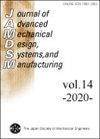汽车车身覆盖件装配弯曲极限应变及弯曲性预测的应力曲线的建立
IF 0.8
4区 工程技术
Q4 ENGINEERING, MANUFACTURING
Journal of Advanced Mechanical Design Systems and Manufacturing
Pub Date : 2022-01-01
DOI:10.1299/jamdsm.2022jamdsm0013
引用次数: 0
摘要
面板。然而,由于成形极限曲线具有不同的破坏机制,变形板料的弯曲程度可能比极限曲线预测的要大,因此,用成形极限曲线来预测折边过程中的可弯曲性是不合适的。本文对基于应变和应力的弯曲极限曲线(BLC)进行了实验和数值模拟,并提出了基于应变和应力的弯曲极限曲线作为汽车车身围合过程的可弯曲性预测工具。实验过程中,通过模拟试验确定了厚度为1.0 mm的双相钢级DP590的基于应变的BLC。首先,采用改进的Marciniak平面内拉伸成形试验对不同几何形状的钢样品进行预拉伸,以便在封边前与冲压工艺进行真实反射。然后,对预拉伸后的试样进行三点弯曲试验,以建立BLC。此外,还研究了不同弯曲半径(0.4和2.0 mm)对弯曲极限应力曲线(BLSCs)和弯曲极限应力曲线的影响。利用冲孔板半径对应的实验BLC数据,结合Hill’48和Yld2000-2d各向异性屈服准则和Swift硬化模型,对所得BLC进行塑性计算。研究发现,发达的BLC比FLC表现出更大的应变水平。显然,冲孔半径越大,BLC和BLSC的应变和应力水平越低。在采用相同屈服准则的情况下,实验用BLSCs的曲线变化趋势相似。综上所述,blc和BLSCs能够较好地预测弯曲和折边过程。计算得到的BLSCs对围合前建立的非线性应变路径不敏感。本文章由计算机程序翻译,如有差异,请以英文原文为准。
Development of bending limit strain and stress curves of bendability prediction for assembling automotive body panels
panels. However, the Forming Limit Curve (FLC) inappropriately induces to predict the bendability in hemming process as it has a different failure mechanism and deformed sheet metals can undergo greater bending than predicted by the FLC. In this work, the newly developed Bending Limit Curve (BLC) based on strain and stress were experimentally and numerically proposed for bendability prediction tools of hemming process in assembling automotive body panels. For the experimental procedures, the BLC based on strain of dual phase steel grade DP590 with a thickness of 1.0 mm was experimentally determined by simulative tests. Firstly, the various steel sample geometries were pre-stretched using the modified Marciniak in-plane stretch-forming tests for realistic reflection with the stamping processes before hemming process. Afterwards, to establish the BLC, the pre-stretched samples were experimentally conducted on a three-point bending test. Moreover, the influence of different bending radius of 0.4 and 2.0 mm on BLC was investigated both of BLCs and Bending Limit Stress Curves (BLSCs). The obtained BLSCs were plastically calculated by using the experimental BLC data corresponding with punch plate radii, which were coupled with anisotropic yield criteria namely, Hill’48 and Yld2000-2d and the Swift hardening model. It was found that the developed BLC exhibited greater strain level than the FLC. Obviously, the higher punch radius established lower strain and stress level of BLC and BLSC, respectively. The experimental BLSCs have the similar trend of their curves which used same yield criterion. In conclusion, the BLCs and BLSCs were completely accomplished to realistically predict the bending and hemming process. The calculated BLSCs are not sensitive with non-linear strain paths which establishes before hemming process.
求助全文
通过发布文献求助,成功后即可免费获取论文全文。
去求助
来源期刊
CiteScore
2.00
自引率
0.00%
发文量
25
审稿时长
4.6 months
期刊介绍:
The Journal of Advanced Mechanical Design, Systems, and Manufacturing (referred to below as "JAMDSM") is an electronic journal edited and managed jointly by the JSME five divisions (Machine Design & Tribology Division, Design & Systems Division, Manufacturing and Machine Tools Division, Manufacturing Systems Division, and Information, Intelligence and Precision Division) , and issued by the JSME for the global dissemination of academic and technological information on mechanical engineering and industries.

 求助内容:
求助内容: 应助结果提醒方式:
应助结果提醒方式:


